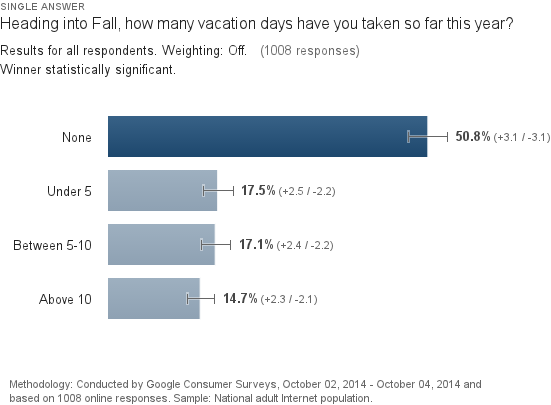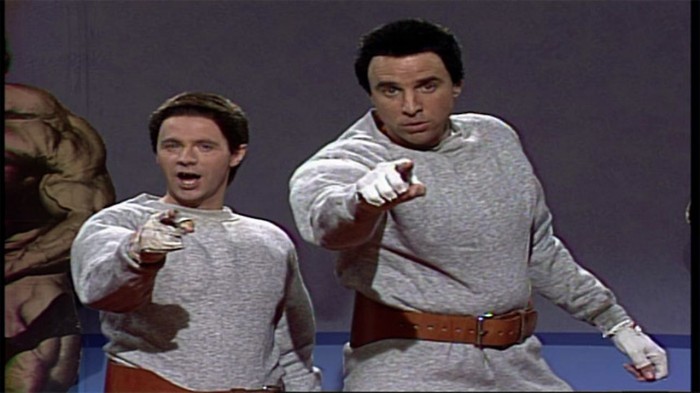Women Face More Deception Than Men During Negotiations
An interesting study just came out of Vanderbilt University that addresses women in business negotiations.
“We found that men and women alike were targeting women with more deception than men,” said Jessica Kennedy, an assistant professor of management at Vanderbilt’s Owen Graduate School of Management and co-author of the study. “It was interesting that men and women alike tried to deceive women in negotiations.”
Please watch the video above, in which Kennedy talks about the study and why women face negative experiences during negotiations.
Vacation Days Still Going Unused by U.S. Workers
It’s October. Do you know where your vacation days are?
According to Skift’s latest travel habits survey, almost 51 percent of U.S. workers say they haven’t taken a single vacation day in 2014 so far.
“About 15 percent of Americans say they have taken more than 10 vacation days this year, while the rest is split between those who took fewer than 5, and those who took between 5-10 vacation days this year,” Rafat Ali reported.
The survey of 1,008 participants also found that women and lower-income Americans take the least amount of vacations.
“More American women than men have taken no vacation days this year,” Ali reported. “On the other hand, more men have taken more than 10 vacation days in the U.S. this year than women.”
Check out the Skift report to learn more results, and if you haven’t schedule a vacation yet, get to it. They’re great for your health, mental and physical.
(Image: Skift)
We Want to Pump…Your Memory Up
Hear me now and believe me later: you can give your memory a lift by lifting weights. So says a Georgia Institute of Technology study released this week that shows working out for as little as 20 minutes can improve a person’s long-term memory.
“Our study indicates that people don’t have to dedicate large amounts of time to give their brain a boost,” said Lisa Weinberg, a Georgia Tech graduate student who led the project.
Previous research has shown how aerobic exercise can improve memory. This study took a new approach. Participants lifted weights just once two days before being tested, and the researchers had the participants answer questions before a workout rather than after one. And even though weight lifting was used, Weinberg said that other resistance activities (e.g., knee bends) may produce the same results.
The reason lifting weights helps improve memory is due to acute stress responses, the researchers suggest.
“Even without doing expensive fMRI scans, our results give us an idea of what areas of the brain might be supporting these exercise-induced memory benefits,” said Audrey Duarte, an associate professor in the School of Psychology at Georgia Tech. “The findings are encouraging because they are consistent with rodent literature that pinpoints exactly the parts of the brain that play a role in stress-induced memory benefits caused by exercise.”
Watch Weinberg explain the study and its results in the video below, and then hit the gym.
(Image: Saturday Night Live/NBC)
Industry News Weekly Roundup
There was a lot of news this past week. Here are some stories that caught our eyes.
SXSW Probably Isn’t Going Anywhere – But Big Changes Loom
—Billboard
“A new report, commissioned by SXSW from international design and event firm Populous, is causing ripples this week because of a recurring theme: the suggestion that the massive Austin-based festival could, if certain suggestions aren’t implemented, solicit bids from other cities to host the event. ”
Why MLB Really Wants You to Have WiFi and a Smart Phone at the Ball Game
—New York Business Journal
“A lot of baseball’s plans to target, retarget and build relationships with its fans depends on a digital connection, so count on much better WiFi league-wide sooner rather than later.”
A Call for an End to Panels
—Amplify
“We’ve been conditioned to believe that they’re necessary for conferences. That we as professional industry folks can only meet if it’s done on a regimented agenda of keynote speeches and expert panels…”
Treating Music Fans as Customers
—Forbes
“Smart rockers have known all along that the fans are the ones who buy the records and the tickets. Without the fans, there would be no concert. And especially as rock n’ roll fans get older, they may be physically unable or psychologically unwilling to be treated more poorly at a rock show than anywhere else.”
PDF: How Can Your Venue Increase Revenue?
—Ungerboeck
“Nine tips to buing a profitable event business for your venue”
Call for Nominations for the 2015 Charles A. McElravy Award
Deadline to submit nominations for the 2015 Charles A. McElravy Award is Nov. 14, 2014.
The Charles A. McElravy Award may be awarded annually to a Professional, Honorary, or Retired member of IAVM who, in the opinion of the Board of Directors has made the greatest lifetime achievement to the welfare of the association or profession.
The following criteria are established for the McElravy Award nominees:
1. The nominee must have been a Professional, Honorary, or Retired Member of the IAVM in good standing for at least fifteen (15) years total (though not necessarily consecutively).
2. The nominee needs to meet the minimum service to IAVM requirements for Honorary Membership, but is not required to be retired. The following criteria must be met for a member to be eligible for consideration for Honorary Membership: 1) Attendance at no fewer than 10 Annual Conferences (VenueConnect) during the past 15 years; 2) Attendance at no fewer than five region meetings during the past 15 years; 3) Service as chair of at least three international or two region committees during the past 15 years; 4) Service as: Director of IAVM or officer in a region at least once during the member’s tenure with IAVM or b) Program chair for an IAVM venue-specific or specialty meeting during the member’s tenure with IAVM or c) Member of Board of Regents, Board of Trustees, or Board of Governors during member’s tenure with IAVM.
3. Any member in good standing may make a nomination, which must provide, in writing, a minimum of three examples of the nominee’s outstanding contributions to IAVM and/or the industry (for example: leadership, accomplishments, professional service/activities, projects/results).
4. At least three letters of recommendation must accompany the nomination letter.
5. No Chairman of the Board (or Past President) of IAVM is eligible for consideration until the third Annual Conference (VenueConnect) following his/her term of office.
6. Previous recipients are ineligible (and may be found on our website under Legacy of Leaders).
The nominations and letters of recommendation should be written to IAVM President and CEO Vicki Hawarden, CMP, and submitted to Rosanne Duke electronically. The nomination letter and all letters of recommendation must be received by close of business Nov. 14, 2014. If you have any questions, please contact Rosanne Duke at 972.538.1025.
Do you want to receive a Front Row News weekly digest?
Categories
- Allied (861)
- Architecture (147)
- Arenas (747)
- Career (897)
- Convention Centers (895)
- Education (623)
- Events (1,544)
- Food & Beverage (193)
- Foundation (113)
- Guest Experience (1,496)
- Industry News (2,270)
- Leadership (1,888)
- Marketing (150)
- Membership (2,000)
- Music (213)
- Performing Arts Centers (454)
- Professional Development (409)
- Research (127)
- Safety & Security (442)
- Sports (763)
- Stadiums (608)
- Student (159)
- Technology (516)
- Ticketing (92)
- Touring (82)
- Trends (364)
- Uncategorized (743)
- Universities (218)
- Video (25)
- Young Professional (198)
Twitter Feed
- Twitter feed loading
Recent Posts
- Venuworks and ATG Entertainment Selected to Manage Fresno Convention and Entertainment Center
- Seattle Convention Center Announces Strategic Leadership Appointment and Growth Initiatives for 2026
- Peggy Daidakis Humbly Made Convention Center History
- Welcome to Our Newest Members
- New Member Benefit! IAVM Partners with Advantage Training to Elevate Staff Readiness and Guest Experience
Categories
- Allied
- Architecture
- Arenas
- Career
- Convention Centers
- Education
- Events
- Food & Beverage
- Foundation
- Guest Experience
- Industry News
- Leadership
- Marketing
- Membership
- Music
- Performing Arts Centers
- Professional Development
- Research
- Safety & Security
- Sports
- Stadiums
- Student
- Technology
- Ticketing
- Touring
- Trends
- Uncategorized
- Universities
- Video
- Young Professional
Archives
- December 2025
- November 2025
- October 2025
- September 2025
- August 2025
- July 2025
- June 2025
- May 2025
- April 2025
- March 2025
- February 2025
- January 2025
- December 2024
- November 2024
- October 2024
- September 2024
- August 2024
- July 2024
- June 2024
- May 2024
- April 2024
- March 2024
- February 2024
- January 2024
- December 2023
- November 2023
- October 2023
- September 2023
- August 2023
- July 2023
- June 2023
- May 2023
- April 2023
- March 2023
- February 2023
- January 2023
- December 2022
- November 2022
- October 2022
- September 2022
- August 2022
- July 2022
- June 2022
- May 2022
- April 2022
- March 2022
- February 2022
- January 2022
- December 2021
- November 2021
- October 2021
- September 2021
- August 2021
- July 2021
- June 2021
- May 2021
- April 2021
- March 2021
- February 2021
- January 2021
- December 2020
- November 2020
- October 2020
- September 2020
- August 2020
- July 2020
- June 2020
- May 2020
- April 2020
- March 2020
- February 2020
- January 2020
- December 2019
- November 2019
- October 2019
- September 2019
- August 2019
- July 2019
- June 2019
- May 2019
- April 2019
- March 2019
- February 2019
- January 2019
- December 2018
- November 2018
- October 2018
- September 2018
- August 2018
- July 2018
- June 2018
- May 2018
- April 2018
- March 2018
- February 2018
- January 2018
- December 2017
- November 2017
- October 2017
- September 2017
- August 2017
- July 2017
- June 2017
- May 2017
- April 2017
- March 2017
- February 2017
- January 2017
- December 2016
- November 2016
- October 2016
- September 2016
- August 2016
- July 2016
- June 2016
- May 2016
- April 2016
- March 2016
- February 2016
- January 2016
- December 2015
- November 2015
- October 2015
- September 2015
- August 2015
- July 2015
- June 2015
- May 2015
- April 2015
- March 2015
- February 2015
- January 2015
- December 2014
- November 2014
- October 2014
- September 2014
- August 2014
- July 2014
- June 2014
- May 2014
- April 2014
- March 2014
- February 2014
- January 2014
- December 2013
- November 2013
- October 2013
- September 2013
- August 2013
- July 2013
- June 2013
- May 2013
- April 2013
- March 2013
- February 2013
- January 2013
- May 2012
- March 2012
- December 2011
- November 2011
- October 2011
Recent Comments
- Frank Bradshaw, Ph.D., CVE on John Meyer, CVE, a Tireless Advocate of Certification for Venue Professionals, Has Died
- Neil Sulkes on Hilary Hartung, Friend to Many in Venue Marketing, Has Left Us
- Jason Parker, CVE on The Devastation of Hurricane Helene and How We Can Support One Another
- Larry Perkins on Touhey Testifies Against Speculative Ticketing Before Congressional Subcommittee
- Peter Secord on Major Players for Planned Elkhart Amphitheater Were in the Mix at VenueConnect




